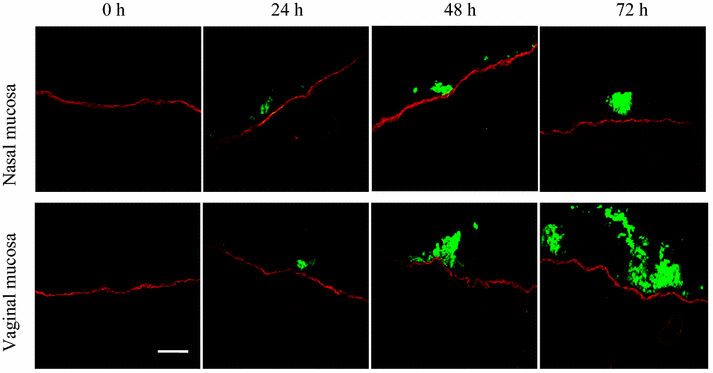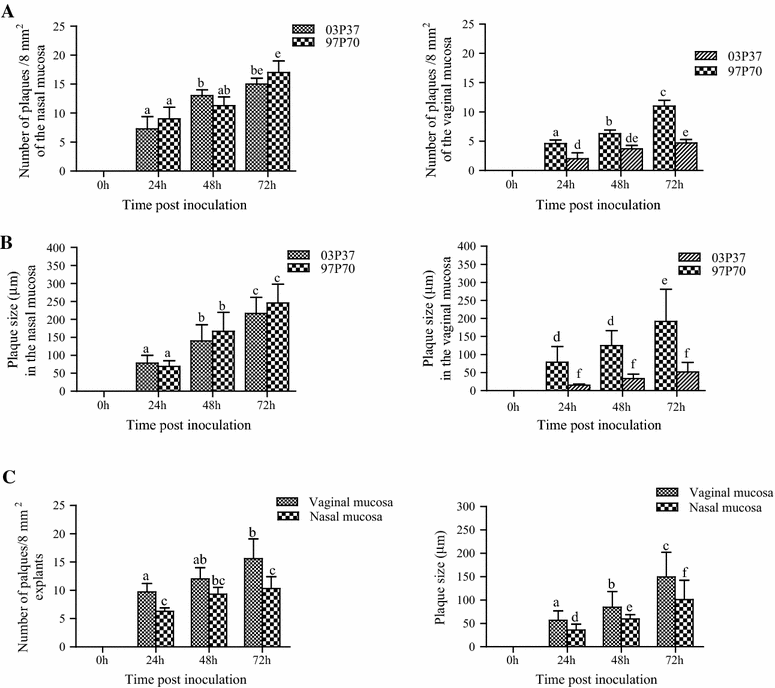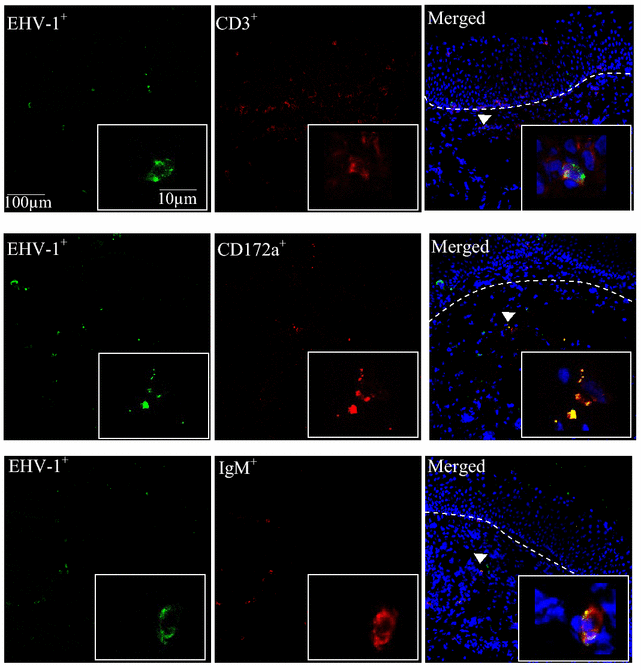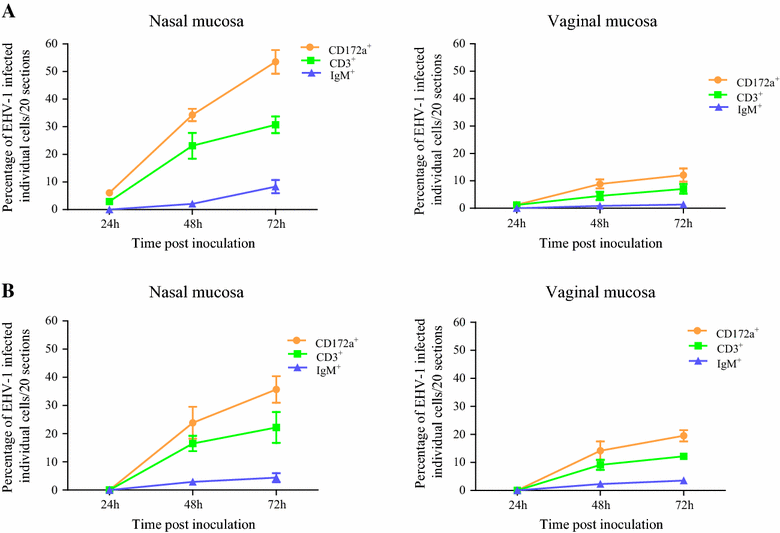Replication characteristics of equine herpesvirus 1 and equine herpesvirus 3: comparative analysis using ex vivo tissue cultures
- PMID: 26768993
- PMCID: PMC4714513
- DOI: 10.1186/s13567-016-0305-5
Replication characteristics of equine herpesvirus 1 and equine herpesvirus 3: comparative analysis using ex vivo tissue cultures
Abstract
Replication kinetics and invasion characteristics of equine herpesvirus-1 and -3 (EHV-1/-3) in nasal and vaginal mucosae were compared using explants. The explants were cultured during 96 h with little change in viability. The tissues were inoculated with EHV-1 03P37 (neuropathogenic), 97P70 (abortigenic) and EHV-3 04P57, collected at 0, 24, 48 and 72 h post inoculation (pi) and stained for viral antigens. Both EHV-1 and EHV-3 replicated in a plaquewise manner. The plaques were already observed at 24 h pi, their size increased over time and did not directly cross the basement membrane (BM). However, EHV-1 infected the monocytic cells (MC) and hijacked these cells to invade the lamina propria. In contrast, EHV-3 replication was fully restricted to epithelial cells; the virus did not breach the BM via a direct cell-to-cell spread nor used infected MC. EHV-1-induced plaques were larger in nasal mucosa compared to vaginal mucosa. The opposite was found for EHV-3-induced plaques. Both EHV-1 strains replicated with comparable kinetics in nasal mucosa. However, the extent of replication of the abortigenic strain in vaginal mucosa was significantly higher than that of the neuropathogenic strain. Two-to-five-fold lower numbers of EHV-1-infected MC underneath the BM were found in vaginal mucosa than in nasal mucosa. Our study has shown that (i) EHV-1 has developed in evolution a predisposition for respiratory mucosa and EHV-3 for vaginal mucosa, (ii) abortigenic EHV-1 replicates better in vaginal mucosa than neuropathogenic EHV-1 and (iii) EHV-3 demonstrated a strict epithelial tropism whereas EHV-1 in addition hijacked MC to invade the lamina propria.
Figures





Similar articles
-
Dual infections of equine herpesvirus 1 and equine arteritis virus in equine respiratory mucosa explants.Virus Res. 2016 Jul 15;220:104-11. doi: 10.1016/j.virusres.2016.04.013. Epub 2016 Apr 23. Virus Res. 2016. PMID: 27117322
-
Genomic analysis and replication kinetics of the closely related EHV-1 neuropathogenic 21P40 and abortigenic 97P70 strains.Vet Res. 2025 Jan 13;56(1):12. doi: 10.1186/s13567-024-01434-3. Vet Res. 2025. PMID: 39806433 Free PMC article.
-
Equine alphaherpesviruses (EHV-1 and EHV-4) differ in their efficiency to infect mononuclear cells during early steps of infection in nasal mucosal explants.Vet Microbiol. 2011 Aug 26;152(1-2):21-8. doi: 10.1016/j.vetmic.2011.03.038. Epub 2011 Apr 12. Vet Microbiol. 2011. PMID: 21536394
-
Impact of equine herpesvirus type 1 (EHV-1) infection on the migration of monocytic cells through equine nasal mucosa.Comp Immunol Microbiol Infect Dis. 2014 Dec;37(5-6):321-9. doi: 10.1016/j.cimid.2014.09.004. Epub 2014 Oct 8. Comp Immunol Microbiol Infect Dis. 2014. PMID: 25456193
-
Streptococcus equi subsp. zooepidemicus Supernatant Containing Streptolysin S Alters the Equine Nasal and Vaginal Mucosa, Modulating Equine Herpesvirus 1, 3 and 4 Infections.Viruses. 2025 Jul 14;17(7):980. doi: 10.3390/v17070980. Viruses. 2025. PMID: 40733597 Free PMC article.
Cited by
-
Equine Coital Exanthema: New Insights on the Knowledge and Leading Perspectives for Treatment and Prevention.Pathogens. 2021 Aug 20;10(8):1055. doi: 10.3390/pathogens10081055. Pathogens. 2021. PMID: 34451519 Free PMC article. Review.
-
Isolation of equine herpesvirus 3 (EHV-3) from equine coital exanthema of two stallions and sero-epidemiology of EHV-3 infection in Japan.J Vet Med Sci. 2017 Mar 23;79(3):636-643. doi: 10.1292/jvms.16-0518. Epub 2017 Jan 27. J Vet Med Sci. 2017. PMID: 28132964 Free PMC article.
-
Characterization of Nasal Mucosal T Cells in Horses and Their Response to Equine Herpesvirus Type 1.Viruses. 2024 Sep 25;16(10):1514. doi: 10.3390/v16101514. Viruses. 2024. PMID: 39459849 Free PMC article.
-
Access to a main alphaherpesvirus receptor, located basolaterally in the respiratory epithelium, is masked by intercellular junctions.Sci Rep. 2017 Nov 30;7(1):16656. doi: 10.1038/s41598-017-16804-5. Sci Rep. 2017. PMID: 29192251 Free PMC article.
-
The Pathogenesis and Immune Evasive Mechanisms of Equine Herpesvirus Type 1.Front Microbiol. 2021 Mar 4;12:662686. doi: 10.3389/fmicb.2021.662686. eCollection 2021. Front Microbiol. 2021. PMID: 33746936 Free PMC article. Review.
References
-
- Allen GP, Kydd JH, Slater JD, Smith KC. Equid herpesvirus 1 and equid herpesvirus 4 infections. In: Coetzer JAW, Tustin RC, editors. Infectious diseases of livestock. Cape Town: Oxford Press; 2004. pp. 829–859.
-
- Allen GP, Umphenour NW. Equine Coital Exanthema. In: Coetzer JAW, Tustin RC, editors. Infectious diseases of livestock. Cape Town: Oxford Press; 2004. pp. 860–867.
Publication types
MeSH terms
LinkOut - more resources
Full Text Sources
Other Literature Sources
Research Materials
Miscellaneous

